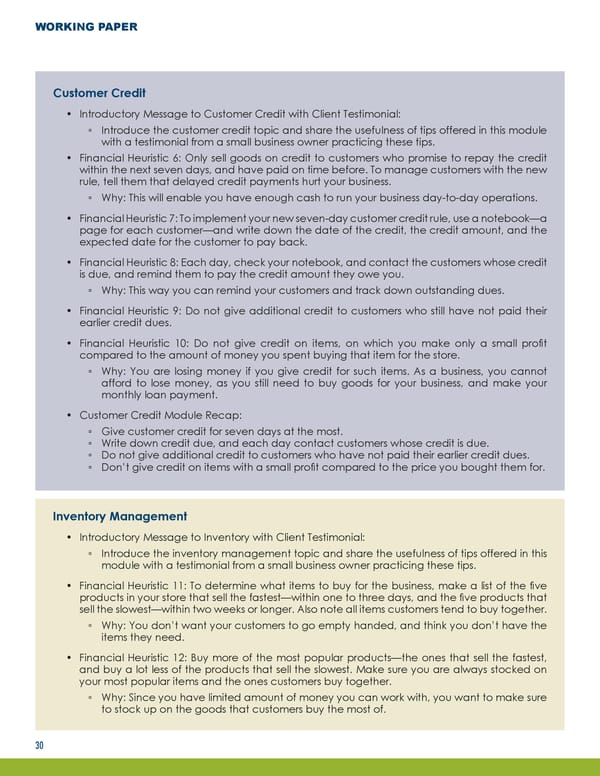WORKING PAPER Customer Credit • Introductory Message to Customer Credit with Client Testimonial: ▫ Introduce the customer credit topic and share the usefulness of tips offered in this module with a testimonial from a small business owner practicing these tips. • Financial Heuristic 6: Only sell goods on credit to customers who promise to repay the credit within the next seven days, and have paid on time before. To manage customers with the new rule, tell them that delayed credit payments hurt your business. ▫ Why: This will enable you have enough cash to run your business day-to-day operations. • Financial Heuristic 7: To implement your new seven-day customer credit rule, use a notebook—a page for each customer—and write down the date of the credit, the credit amount, and the expected date for the customer to pay back. • Financial Heuristic 8: Each day, check your notebook, and contact the customers whose credit is due, and remind them to pay the credit amount they owe you. ▫ Why:This way you can remind your customers and track down outstanding dues. • Financial Heuristic 9: Do not give additional credit to customers who still have not paid their earlier credit dues. • Financial Heuristic 10: Do not give credit on items, on which you make only a small profit compared to the amount of money you spent buying that item for the store. ▫ Why: You are losing money if you give credit for such items. As a business, you cannot afford to lose money, as you still need to buy goods for your business, and make your monthly loan payment. • Customer Credit Module Recap: ▫ Give customer credit for seven days at the most. ▫ Write down credit due, and each day contact customers whose credit is due. ▫ Do not give additional credit to customers who have not paid their earlier credit dues. ▫ Don’t give credit on items with a small profit compared to the price you bought them for. Inventory Management • Introductory Message to Inventory with Client Testimonial: ▫ Introduce the inventory management topic and share the usefulness of tips offered in this module with a testimonial from a small business owner practicing these tips. • Financial Heuristic 11: To determine what items to buy for the business, make a list of the five products in your store that sell the fastest—within one to three days, and the five products that sell the slowest—within two weeks or longer. Also note all items customers tend to buy together. ▫ Why: You don’t want your customers to go empty handed, and think you don’t have the items they need. • Financial Heuristic 12: Buy more of the most popular products—the ones that sell the fastest, and buy a lot less of the products that sell the slowest. Make sure you are always stocked on your most popular items and the ones customers buy together. ▫ Why: Since you have limited amount of money you can work with, you want to make sure to stock up on the goods that customers buy the most of. 30
 Using Behavioral Science to Design a Customer-Centric Financial Management Training for Microentrepreneurs Page 32 Page 34
Using Behavioral Science to Design a Customer-Centric Financial Management Training for Microentrepreneurs Page 32 Page 34